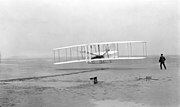There are records of early short-distance flights from the 9th to 11th centuries, such as the parachute flight of Armen Firman, the glider flight of Abbas Ibn Firnas, and possibly earlier human-carrying kites from China.
The modern age of aviation began with the first untethered human lighter-than-air flight on November 21, 1783, in a hot air balloon designed by the Montgolfier brothers, and balloon flight became increasingly common over longer and longer distances throughout the 19th century, continuing to the present.
The practicality of balloons was limited by the fact that they could only travel downwind. It was immediately recognized that a steerable, or dirigible, balloon was required. Although several airships, as steerable balloons came to be called, were built during the 1800s, the first aircraft to make routine flights were made by the Brazilian aviation pioneer Alberto Santos-Dumont. Santos-Dumont effectively combined an elongated balloon with an internal combustion engine. On October 19, 1901 he became world famous when he flew his airship "Number 6" over Paris to win the Deutsch de la Meurthe prize. Santos-Dumont's success with airships proved that controlled and sustained flight was possible.
On December 17, 1903, the Wright brothers flew the first successful powered, heavier-than-air flight, though their aircraft was impractical to fly for more than a short distance because of control problems. The widespread adoption of ailerons made aircraft much easier to manage, and only a decade later, at the start of World War I, heavier-than-air powered aircraft had become practical for reconnaissance, artillery spotting, and even attacks against ground positions.
Aircraft began to transport people and cargo as designs grew larger and more reliable. In contrast to small non-rigid blimps, giant rigid airships became the first aircraft to transport passengers and cargo over great distances. The best known aircraft of this type were manufactured by the German Zeppelin company.
The most successful Zeppelin was the Graf Zeppelin. It flew over one million miles, including an around the world flight in August of 1929. However, the dominance of the Zeppelins over the airplanes of the that period, which had a range of only a few hundred miles, was diminishing as airplane design advanced. The "Golden Age" of the airships ended on June 6, 1937 when the Hindenburg caught fire killing 36 people. Although there have been periodic initiatives to revive their use, airships have seen only niche application since that time.
Great progress was made in airplane design during the 1920s and 1930s. One of the most successful designs of this period was the Douglas DC-3 which became the first airliner that was profitable carrying passengers exclusively, starting the modern era of passenger airline service. By the beginning of World War II, many towns and cities had built airports, and there were numerous qualified pilots available. The war brought many innovations to aviation, including the first jet aircraft and the first liquid-fueled rockets.
After WWII, especially in North America, there was a boom in general aviation, both private and commercial, as thousands of pilots were released from military service and many inexpensive war-surplus transport and training aircraft became available. Manufacturers such as Cessna, Piper, and Beechcraft expanded production to provide light aircraft for the new middle class market.
By the 1950s, the development of civil jets grew, beginning with the de Havilland Comet, though the first widely-used passenger jet was the Boeing 707. At the same time, turboprop propulsion began to appear for smaller commuter planes, making it possible to serve small-volume routes in a much wider range of weather conditions.
Yuri Gagarin was the first human to travel to space on April 12, 1961, while Neil Armstrong was the first to set foot on the moon on July 21, 1969.
Since the 1960s, composite airframes and quieter, more efficient engines have become available, but the most important innovations have taken place in instrumentation and control. The arrival of solid-state electronics, the Global Positioning System, satellite communications, and increasingly small and powerful computers and LED displays, have dramatically changed the cockpits of airliners and, increasingly, of smaller aircraft as well. Pilots can navigate much more accurately and view terrain, obstructions, and other nearby aircraft on a map or through synthetic vision, even at night or in low visibility.
On June 21, 2004, SpaceShipOne became the first privately funded aircraft to make a spaceflight, opening the possibility of an aviation market outside the earth's atmosphere.



No comments:
Post a Comment